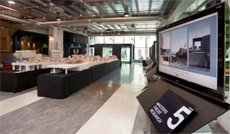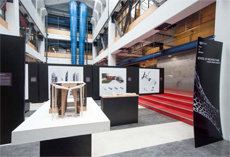The future of a Wellington's most iconic street
Press release by New Zealand Historic Places Trust

An architecture project focusing on earthquake-strengthening heritage buildings on Wellington’s iconic Cuba Street has provided a snapshot of how it may look in 2035.
Fourth-year students from the School of Architecture have produced plans showing how the street's buildings could be strengthened, as well as a physical model of the street.
The students developed plans for 70 buildings as part of the project, which was supervised by practising structural engineers and architects, and supported by New Zealand Historic Places Trust (NZHPT) and Wellington City Council.
Course coordinator Mark Southcombe says a public meeting to present the concepts to building owners has produced some excellent feedback.
"Owners are really delighted that we have taken an interest in this part of the city. They have got major issues at the moment, particularly to do with the high costs of insurance that they have no control over. They suddenly have to look very hard at the issues of strengthening or redeveloping their buildings.
"To have examples of innovative design solutions is fascinating and very helpful to them. It shows ways of dealing with problems they wouldn’t necessarily think of."
Mr Southcombe says the project encouraged students to look at architectural responses and seismic retrofit solutions for individual buildings as well as clusters of buildings.

"One of the really positive things to come out of the whole process is that because we looked at the whole street, the effect of buildings on each other was highlighted. One of the biggest problems treating such buildings is the effect of pounding on adjacent buildings during an earthquake. The potential of collaboration between owners is not often taken into account. Typically owners work with one building in isolation, but this project has shown that you can get some absolutely innovative and fantastic results when people collaborate."
Mr Southcombe says the diversity of creative design solutions by the students reflects a broad range of views about heritage.
Architectural student Hamish Byrne, 22, says working with Cuba Street’s heritage buildings has been something of a privilege.
"I redesigned the Albermarle. You can see the layers of history that have built up and accumulated over time just looking at it. Transforming it into a high-end luxury hotel made sense to me; it just seemed proper. And it was a real pleasure to add another chapter to its story."
Fellow student Alex Sawicka-Ritchie, 22, says Cuba Street has been a big part of her life growing up in Wellington.
"I know the area well and have always loved the character that the heritage buildings add to the Cuba Street precinct, which is why working on both the Ghuznee and Cadbury’s Buildings was such a pleasure for me," says Alex.

"That’s why I didn’t tamper with them too much. I’ve retained certain elements that tell the story of the buildings’ past, while adapting it to the needs of Cuba Street in 2035 by inserting an intervention that wraps over and into the shell of the existing building, intensifying the area."
NZHPT Central Region General Manager Ann Neill says the project has been an opportunity to focus on a positive future for the street’s largely unreinforced masonry buildings and to allay owner concerns by starting the conversation on seismic design solutions and adaptive reuse.
"This project is not just about Cuba Street, it is about looking at the future of heritage buildings throughout New Zealand, making them affordable and sustainable in ways that are achievable.
"Overall the project has produced an exciting and bold vision of how Cuba Street could look in the future. It is vibrant, bohemian and dynamic–showing we can cope with change."
